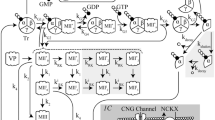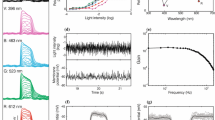summary
The dynamic response of a simple ganglionic photoreceptor has been studied. It exemplifies the general processes of sensory reception and transmission of sensory information in the form of trains of nerve impulses. The experimental basis of the defining linear transfer function is presented. This transfer function is composed of a second order lag and a transport delay. The ventral nerve cord conduction time does not contribute to the transport delay. Nonlinear discrepancies from the linear model are evaluated and discussed.
Similar content being viewed by others
References
Pringle, J. W. S., and V. J. Wilson: The response of a sense organ to a harmonic stimulus. J. exp. Biol. 29, 220 (1952).
Stark, L., and P. M. Sherman: A servoanalytic study of the consensual pupil reflex to light. J. Neurophysiol. 20, 17 (1957).
Stark, L.: Transfer function of a biological photoreceptor, WADC technical report 59–311, 1959.
Hartline, H. K.: A quantitative and descriptive study of the electrical response to illumination of the arthropod eye. Amer. J. Physiol. 83, 466 (1928).
Prosser, C. L.: Action potentials in the nervous system of the crayfish, a. Response to illumination of the eye and caudal ganglion. J. cell comp. Physiol. 4, 363 (1934).
Welsh, J. H.: The caudal photoreceptor and Responses of the crayfish to light. J. cell comp. Physiol. 4, 363 (1934).
Kennedy, D.: Responses from the crayfish caudal photoreceptor. Amer. J. Ophthal. 11, 19 (1958).
Wiersma, C. A. G.: Giant nerve fiber system of the crayfish. A contribution to comparative physiology of synapses. J. Neurophysiol. 10, 23 (1947).
Kropp, B., and E. V. Enzmann: Photic stimulation and leg movements in the crayfish. J. gen. Physiol. 16, 905 (1933).
Hermann, H. T., and L. Stark: Random walk response of the crayfish. Quart. Prog. Reports, Res. Lab. Electronics, M.I.T. 61, 230 (1961).
Kennedy, D., and J. B. Preston: Activity patterns of interneurones in the caudal ganglion of the crayfish. J. gen. Physiol. 43, 655 (1960).
Wiersma, C. A. G., S. H. Ripley and E. Christensen: The central representation of sensory stimulation in the crayfish. J. cell comp. Physiol. 46, 307 (1955).
Stark, L.: Stability, oscillations and noise in the human pupil, servomechanism. Proc. I.R.E. 47, 1925 (1959).
England, T. E., and H. T. Hermann: Transmission of neural impulses in the ventral cord of the crayfish. Tech. Report. Res. Lab. Electronics (in preparation).
Hermann, H. T., and L. Y. Young: Field recording characteristics of neurophysiological microelectrodes. Technical Report. Res. Lab. Electronics (in preparation).
Hermann, H. T., L. Stark and P. A. Willis: Instrumentation for recording and processing neural impulses. Technical Report. Res. Lab. Electronics (in preparation).
Author information
Authors and Affiliations
Additional information
This research is supported in part by the Air Force (AF-33(616)-7282); the Office of Naval Research [Nonr-609(39)]: the Army Chemical Corp. (Da-18-108-405-Cml-942); and the U.S. Public Health Service (B-3055, B-3090).
Rights and permissions
About this article
Cite this article
Stark, L., Hermann, H.T. The transfer function of a photoreceptor organ. Kybernetik 1, 124–129 (1961). https://doi.org/10.1007/BF00290183
Received:
Issue Date:
DOI: https://doi.org/10.1007/BF00290183




